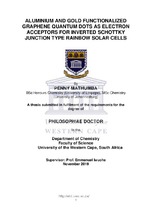| dc.contributor.advisor | Iwuoha, Emmanuel | |
| dc.contributor.author | Mathumba, Penny | |
| dc.date.accessioned | 2020-04-16T12:52:23Z | |
| dc.date.issued | 2020 | |
| dc.identifier.uri | http://hdl.handle.net/11394/7232 | |
| dc.description | Philosophiae Doctor - PhD | en_US |
| dc.description.abstract | The main aim of this study was to prepare band gap-engineered graphene quantum dot (GQD) structures which match the different energies of the visible region in the solar spectrum. These band gap-engineered graphene quantum dot structures were used as donor materials in rainbow Schottky junction solar cells, targeting all the energies in the visible region of the solar spectrum for improved solar-to-electricity power conversion efficiency. Structural characterisation of the prepared nanomaterials under solid-state nuclear magnetic resonance spectroscopy (SS-NMR) showed appearance of bands at 40 ppm due to the presence of sp3 hybridised carbon atoms from the peripheral region of the GQD structures. Other bands were observed at 130 ppm due to the presence of polycyclic aromatic carbon atoms from the benzene rings of the GQD backbone, and around 180 ppm due to the presence of carboxylic acid carbons from oxidation due to moisture. Fourier-transform infrared resonance (FTIR) spectroscopy further confirmed the presence of aromatic carbon atoms and oxidised carbons due to the presence of C=O, C=C and -OH functional groups, concurrent with SS-NMR results. | en_US |
| dc.language.iso | en | en_US |
| dc.publisher | University of Western Cape | en_US |
| dc.subject | Band-gap engineering | en_US |
| dc.subject | Graphene quantum dots | en_US |
| dc.subject | Schottky junction solar cells | en_US |
| dc.subject | Solar energy | en_US |
| dc.subject | Solar spectrum | en_US |
| dc.title | Aluminium and gold functionalized graphene quantum dots as electron acceptors for inverted Schottky junction type rainbow solar cells | en_US |
| dc.rights.holder | University of Western Cape | en_US |
| dc.description.embargo | 2023-12-01 | |

